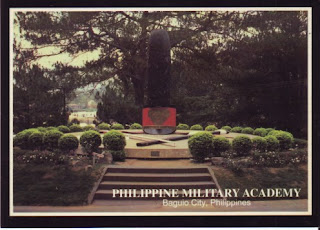26 July, 2008
University of the Philippines, Diliman Postcards
The University of the Philippines, Diliman, or U.P. Diliman, was established in 1908 with three initial colleges, the College of Fine Arts, the College of Liberal Arts and the College of Medicine and Surgery occupying buildings distributed along Padre Faura and R. Hidalgo in Manila.
Both postcards also show the Oblation which is the iconic symbol of the University of the Philippines, represented by a man with arms wide-stretched and face facing up, symbolizing selfless offering of one's self to his country. The Oblation was made by Professor Guillermo E. Tolentino with the help of Anastacio T. Caedo, his student apprentice.
25 July, 2008
University of San Carlos Postcard
The University of San Carlos (USC) in Cebu City is the oldest school in the Philippines. Founded by Spanish Jesuits in 1595, it is a Catholic institution of higher learning run by the Society of the Divine Word or SVD since 1935. The University was named after St. Charles Borromeo.
The university traces its origins to the founding of the school Colegio de San Ildefonso, founded by the Spanish Jesuits fathers Antonio Sedeno, Pedro Chirino and Antonio Pereira on August 1, 1595. It was closed in 1769 at the expulsion of the Jesuits. In 1783, the initiative of the Bishop Mateo Joaquin de Arevalo opened the Colegio-Seminario de San Carlos. The Second World War led to the interruption of the courses in 1941 because several buildings suffered various destruction. The Colegio de San Carlos was granted its university charter in 1948.
SOURCE:University of San Carlos Wikipedia Entry
The university traces its origins to the founding of the school Colegio de San Ildefonso, founded by the Spanish Jesuits fathers Antonio Sedeno, Pedro Chirino and Antonio Pereira on August 1, 1595. It was closed in 1769 at the expulsion of the Jesuits. In 1783, the initiative of the Bishop Mateo Joaquin de Arevalo opened the Colegio-Seminario de San Carlos. The Second World War led to the interruption of the courses in 1941 because several buildings suffered various destruction. The Colegio de San Carlos was granted its university charter in 1948.
SOURCE:University of San Carlos Wikipedia Entry
24 July, 2008
University of Baguio Postcard
The University of Baguio was founded by Dr. and Mrs. Fernando G. Bautista and was at first known as Baguio Technical and Commercial Institute, but people loved to call it Baguio Tech. After two decades of service, it was granted university status on August 7, 1969.
23 July, 2008
Saint Louis University, Baguio City Postcard
Saint Louis University, my Alma Mater, was founded in 1911 by Congregatio Immaculati Cordis Mariae missionaries. SLU is the largest university in the Northern Philippines with, 20,750 as of November 17, 2007, the students coming all regions of the Philippines as well as overseas.
Its six hectare campus is located 250 kilometers north of Manila in Baguio City. The 30 building campus is located centrally in Baguio drawing an eclectic mix of cultures and nationalities.
SOURCE:
Saint Louis University, Baguio City Wikipedia Entry
Its six hectare campus is located 250 kilometers north of Manila in Baguio City. The 30 building campus is located centrally in Baguio drawing an eclectic mix of cultures and nationalities.
SOURCE:
Saint Louis University, Baguio City Wikipedia Entry
22 July, 2008
Philippine Military Academy Postcards
The Philippine Military Academy (PMA) is the training school for future officers of the Armed Forces of the Philippines. The Philippine Military Academy traces its history back to the Academia Militar which was established on October 25, 1898 at Malolos, Bulacan by General Emilio Aguinaldo.
During the U.S. occupation of the Philippines, an Officer's School of the Philippine Constabulary was established on February 17, 1905 within the walls of Intramuros in Manila located in Sta. Lucia Barracks. This school was relocated to Baguio on September 01, 1908 on the site known as Constabulary Hill later renamed Camp Henry T. Allen.
With the outbreak of World War II, training was disrupted at the PMA with Classes 1942 and 1943 being graduated prematurely and assigned to combat units in Bataan and other parts of the country.The PMA headquarters was temporarily relocated at Camp Murphy (now known as Camp Aguinaldo) and later at Alabang, while Camp Allen was being rehabilitated.
After the war, the Academy was reopened on May 05, 1947, at Camp Henry T. Allen. But due to its increasing need for wider grounds, it was soon moved to its present location at Fort Del Pilar, Loakan.
During the U.S. occupation of the Philippines, an Officer's School of the Philippine Constabulary was established on February 17, 1905 within the walls of Intramuros in Manila located in Sta. Lucia Barracks. This school was relocated to Baguio on September 01, 1908 on the site known as Constabulary Hill later renamed Camp Henry T. Allen.
With the outbreak of World War II, training was disrupted at the PMA with Classes 1942 and 1943 being graduated prematurely and assigned to combat units in Bataan and other parts of the country.The PMA headquarters was temporarily relocated at Camp Murphy (now known as Camp Aguinaldo) and later at Alabang, while Camp Allen was being rehabilitated.
After the war, the Academy was reopened on May 05, 1947, at Camp Henry T. Allen. But due to its increasing need for wider grounds, it was soon moved to its present location at Fort Del Pilar, Loakan.
Subscribe to:
Comments (Atom)









